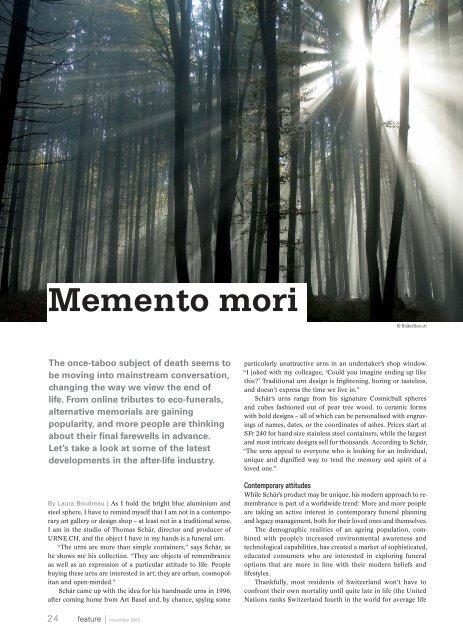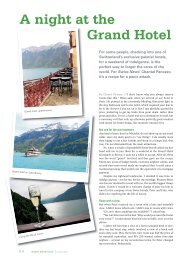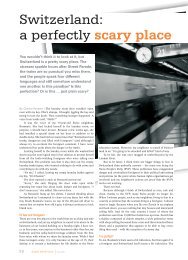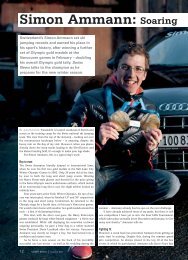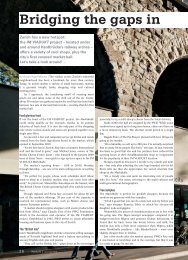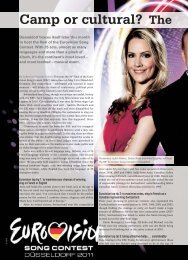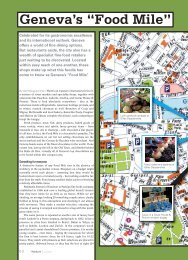Memento mori - Swiss News
Memento mori - Swiss News
Memento mori - Swiss News
You also want an ePaper? Increase the reach of your titles
YUMPU automatically turns print PDFs into web optimized ePapers that Google loves.
<strong>Memento</strong> <strong>mori</strong><br />
© BilderBox.ch<br />
The once-taboo subject of death seems to<br />
be moving into mainstream conversation,<br />
changing the way we view the end of<br />
life. From online tributes to eco-funerals,<br />
alternative me<strong>mori</strong>als are gaining<br />
popularity, and more people are thinking<br />
about their final farewells in advance.<br />
Let’s take a look at some of the latest<br />
developments in the after-life industry.<br />
By Laura Boudreau | As I hold the bright blue aluminium and<br />
steel sphere, I have to remind myself that I am not in a contemporary<br />
art gallery or design shop – at least not in a traditional sense.<br />
I am in the studio of Thomas Schär, director and producer of<br />
URNE.CH, and the object I have in my hands is a funeral urn.<br />
“The urns are more than simple containers,” says Schär, as<br />
he shows me his collection. “They are objects of remembrance<br />
as well as an expression of a particular attitude to life. People<br />
buying these urns are interested in art; they are urban, cosmopolitan<br />
and open-minded.”<br />
Schär came up with the idea for his handmade urns in 1996,<br />
after coming home from Art Basel and, by chance, spying some<br />
particularly unattractive urns in an undertaker’s shop window.<br />
“I joked with my colleague, ‘Could you imagine ending up like<br />
this’ Traditional urn design is frightening, boring or tasteless,<br />
and doesn’t express the time we live in.”<br />
Schär’s urns range from his signature Cosmicball spheres<br />
and cubes fashioned out of pear tree wood, to ceramic forms<br />
with bold designs – all of which can be personalised with engravings<br />
of names, dates, or the coordinates of ashes. Prices start at<br />
SFr 240 for hand-size stainless steel containers, while the largest<br />
and most intricate designs sell for thousands. According to Schär,<br />
“The urns appeal to everyone who is looking for an individual,<br />
unique and dignified way to tend the memory and spirit of a<br />
loved one.”<br />
Contemporary attitudes<br />
While Schär’s product may be unique, his modern approach to remembrance<br />
is part of a worldwide trend: More and more people<br />
are taking an active interest in contemporary funeral planning<br />
and legacy management, both for their loved ones and themselves.<br />
The demographic realities of an ageing population, combined<br />
with people’s increased environmental awareness and<br />
technological capabilities, has created a market of sophisticated,<br />
educated consumers who are interested in exploring funeral<br />
options that are more in line with their modern beliefs and<br />
lifestyles.<br />
Thankfully, most residents of Switzerland won’t have to<br />
confront their own mortality until quite late in life (the United<br />
Nations ranks Switzerland fourth in the world for average life<br />
24 feature ⏐ november 2010
Contemporary ideas about mortality inspire new resting places (some with very modern designs, as shown by Thomas Schär)<br />
© URNE.CH<br />
expectancy – its inhabitants live longer than people in any other<br />
country in continental Europe), but that isn’t stopping a growing<br />
number of people from planning ahead and exploring some<br />
more unusual options.<br />
Living legacy<br />
Cemeteries are traditional resting places, but space in Switzerland<br />
is at a premium: After a number of years (as specified by the<br />
particular canton), relatives of the deceased are required to clear<br />
away the gravestone, so the plot can be re-used. Other land use<br />
concerns – including those from environmental groups who<br />
contend that casket burial contaminates water and soil – have<br />
led people to seek out more eco-friendly alternatives, including<br />
cremation.<br />
Cremation in Switzerland dates back to 1889, when the first<br />
crematorium (the third such facility in Europe) was built, and<br />
today it is a popular alternative to burial: The <strong>Swiss</strong> opt to be<br />
cremated 75 per cent of the time. Families must then decide what<br />
to do with the ashes. For some, a Friedwald burial is the answer.<br />
Friedwald is the brainchild of Ueli Sauter, who started the<br />
company in 1993 after the death of a dear friend. The concept is<br />
both simple and touchingly symbolic: Families can bury their<br />
loved one’s ashes at the base of a pre-selected tree in a natural<br />
forest. The monument to the person’s memory becomes a living<br />
tree, marked only by a small painted sign or plaque. Land<br />
registries protect the over 60 Friedwald locations across Switzerland<br />
for up to 99 years.<br />
At 4,900 <strong>Swiss</strong> francs, a Friedwald tree doesn’t come cheap,<br />
but price wasn’t what 59-year-old Myrtha Niedermann was thinking<br />
about when she chose hers – a sun-dappled cherry overlooking<br />
the river in Mammern, Canton Thurgau.<br />
“I have no family, only my faithful pets,” Niedermann says,<br />
noting that she would like to be buried with her animals, a relatively<br />
common practice in Friedwald forests. “I have no one to<br />
maintain my grave, and I would not like to be buried in a common<br />
grave.” Indeed, many Friedwald customers take comfort in<br />
the zero-maintenance aspect of a Friedwald burial, not wanting<br />
to be a burden to their loved ones.<br />
While Niedermann says that not all her friends understand her<br />
unconventional plans, she knows she has made the right decision.<br />
“I love the forest,” she says. “I’m very glad that Friedwald exists.”<br />
Click here to R.I.P.<br />
Aside from physical remains, there is also the issue of what to do<br />
with the digital selves we leave behind: What happens to all<br />
those Facebook, Twitter and MySpace accounts, Flickr photos,<br />
blogs and online avatars after we die<br />
Swedish entrepreneurs Lisa Granberg and Elin Tybring asked<br />
themselves this question and were disturbed by the answer they<br />
arrived at. “We realised that individuals had no control over their<br />
digital identities after death,” says Granberg, adding that family<br />
members wanting to wind down a loved one’s online life often<br />
find themselves locked out of accounts. “We want people to be<br />
able to take control of their lives online, even after they die.”<br />
In October 2009, the women launched MyWebWill.com, a<br />
subscription service designed to give users the power to control<br />
feature ⏐ november 2010 25
their web-based afterlife. “You might want to deactivate your<br />
Facebook account, or forward important passwords to a relative,<br />
for example,” says Granberg. “You could send a last Tweet, or<br />
thank the readers of your blog. The possibilities are endless.<br />
After we confirm your death, we simply carry out your wishes.<br />
We like to compare ourselves to an insurance company, but an<br />
insurance company for your web life.”<br />
MyWebWill.com is now available worldwide. “More and<br />
more people are living part of their lives on the Internet. My<br />
father just got a Facebook account, and he’s 73,” she says with a<br />
laugh. Does Granberg have her own MyWebWill account “Of<br />
course! This idea came out of a personal interest.”<br />
Eternal life<br />
Many people want to leave something behind for future generations,<br />
but technology is putting a new spin on this age-old<br />
impulse. What if you could store your DNA in a nuclear bombproof,<br />
military facility, high in the <strong>Swiss</strong> Alps No, it’s not<br />
science fiction, merely the service offered by the company <strong>Swiss</strong><br />
DNA Bank. As its name suggests, <strong>Swiss</strong> DNA Bank will store<br />
your genetic code, along with your digital me<strong>mori</strong>es, in one of its<br />
vaults, preserving both for eternity.<br />
“At the end of our lives, we lose everything about ourselves –<br />
our DNA, the core biological element of our bodies, and our<br />
me<strong>mori</strong>es,” says Luca Boschin, the chief operating officer of<br />
<strong>Swiss</strong> DNA Bank. “We are offering people a secure place to preserve<br />
this very important information.”<br />
For US$ 299, subscribers can store up to one gigabyte of data,<br />
including text, video, audio, or images. An additional US$ 100<br />
pays for DNA storage: A DNA data collection kit is sent to the<br />
subscriber, and a self-administered cheek swab is sent back in a<br />
pre-paid envelope.<br />
The information is protected by rigorous access protocols,<br />
akin to <strong>Swiss</strong> banking systems. “You can choose to keep this<br />
information private, for your own peace of mind, or you may<br />
want to make it available to friends and family, your future genetic<br />
descendents, or even the public,” says Boschin. “We are very proud<br />
More information<br />
Contemporary funeral urns by Thomas Schär: www.urne.ch<br />
Friedwald forests: www.ecoeternity.com<br />
MyWebWill: www.mywebwill.com<br />
<strong>Swiss</strong> DNA Bank: www.swissdnabank.com<br />
© BilderBox.ch<br />
of being a <strong>Swiss</strong> company, and we are pleased to be able to offer<br />
our subscribers protected storage in a safe, neutral country.”<br />
Could this genetic material be used to clone people back to<br />
life sometime in the future Today, the idea is far-fetched, but<br />
Boschin notes the medical science is always advancing. “Who<br />
knows what might be possible in a hundred years At the very<br />
least, the DNA might be useful for researching and treating genetic<br />
diseases.”<br />
However, despite our best attempts at preservation, death is<br />
still an unavoidable – though often overlooked – part of life.<br />
Elisabeth Kübler-Ross, the <strong>Swiss</strong>-born American psychiatrist<br />
and author of the groundbreaking book On Death and Dying,<br />
wrote in 1975, “It is difficult to accept death in this society<br />
because it is unfamiliar. In spite of the fact that it happens all the<br />
time, we never see it.” Perhaps the emergence of these new<br />
options for planning our me<strong>mori</strong>als will bring us one step closer<br />
to accepting the inevitable.<br />
26 feature ⏐ november 2010


